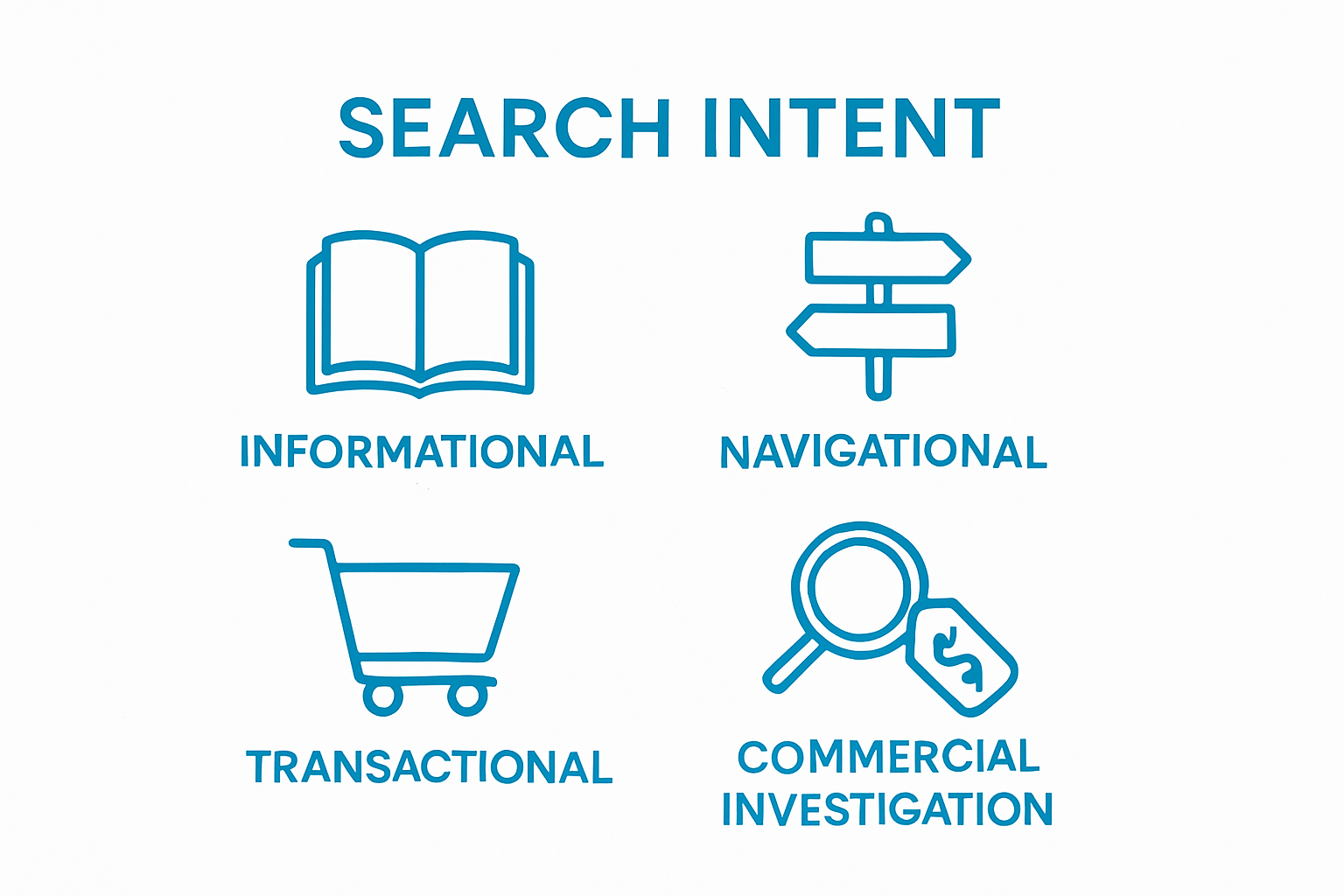Search engines have become the gateway to almost everything we do online, funneling billions of queries through their invisible machinery every single day. Most people know Google as a household name, yet over 90 percent of all web traffic goes through search engines. You might expect their magic is all about keywords or flashy shortcuts. It goes way deeper. The coolest part is how these platforms have evolved from basic site directories into intelligent tools that decode your actual intent and deliver answers before you even finish typing.
Table of Contents
- What Are Search Engines And Their Evolution?
- The Importance Of User Intent In Search Engine Functionality
- Technologies Shaping The Future: Ai And Machine Learning
- The Role Of Voice Search And Visual Search In User Experience
- Future Trends In Seo: Preparing For Adaptation And Change
Quick Summary
| Takeaway | Explanation |
|---|---|
| Search engines use crawling, indexing, and ranking | The essential processes for search engines to operate efficiently and deliver accurate results involve crawling web pages, indexing information, and ranking relevance. |
| Understanding user intent is crucial | Recognizing the type of search intent helps search engines provide accurate and tailored results for users’ specific needs. |
| AI and machine learning enhance search capabilities | Advanced technologies allow search engines to learn from data, improving their ability to understand user queries and refine search results dynamically. |
| Voice and visual search are game changers | These technologies offer users intuitive ways to interact with search engines, moving beyond text inputs and enhancing overall search experiences. |
| Stay updated on SEO trends to adapt | As search engines evolve, SEO strategies must also change to align with new technologies and user behaviors to maintain visibility online. |
What Are Search Engines and Their Evolution?
Search engines are sophisticated digital navigation systems that help users find relevant information across the vast landscape of the internet. These powerful technological platforms operate through complex algorithms designed to crawl, index, and retrieve web content based on user queries.
The Core Mechanics of Search Engines
At their fundamental level, search engines function through three primary processes: crawling, indexing, and ranking. Web crawlers systematically browse websites, collecting data about each page’s content, structure, and links. This information is then organized into a massive digital index, similar to an extensive library catalog. When a user enters a search query, the engine rapidly analyzes this index to provide the most relevant and authoritative results.
According to research from the Stanford Encyclopedia of Philosophy, search engines have profoundly transformed how humans access and interact with information, becoming critical infrastructure in our digital communication ecosystem.
Historical Progression and Technological Advancements
Search engine technology has undergone remarkable transformations since its inception. Early search platforms like AltaVista and Yahoo were manually curated directories. Google revolutionized the field by introducing PageRank, an algorithm that evaluated webpage importance based on incoming links and credibility. Modern search engines now incorporate artificial intelligence, machine learning, and natural language processing to understand context and user intent.
This table summarizes the key technological milestones highlighted in the article, illustrating the progression of search engine technology over time.
| Milestone | Description |
|---|---|
| Keyword Matching | Early search engines relied on matching exact keywords in queries |
| Semantic Understanding | Search engines advanced to interpret meaning and context |
| Machine Learning Integration | Algorithms began learning from data for more accurate results |
| Personalized Search Experiences | Results are customized based on user history and preferences |
| Mobile and Voice Search Enhancement | Improved searches for mobile devices and through spoken commands |
Key technological milestones in search engine evolution include:
- Transition from keyword matching to semantic understanding
- Integration of machine learning for more precise results
- Development of personalized search experiences
- Enhanced mobile and voice search capabilities
Today’s search engines are not merely information retrieval tools but intelligent systems that learn more about advanced search techniques and continuously adapt to user behaviors and technological innovations.
The Importance of User Intent in Search Engine Functionality
User intent represents the underlying motivation behind a search query, transforming search engines from simple keyword matching platforms into intelligent interpretation systems. Understanding why users search helps create more precise, relevant, and personalized search experiences.
Decoding Search Intent Categories
Search intent typically falls into four primary categories that reveal users’ fundamental objectives:
- Informational Intent: Users seeking knowledge or answers to specific questions
- Navigational Intent: Users attempting to locate a particular website or webpage
- Transactional Intent: Users planning to complete a purchase or specific action
- Commercial Investigation Intent: Users researching products before making a purchasing decision
By recognizing these distinct intent types, search engines can deliver more nuanced and contextually appropriate results that match users’ precise expectations.
To clarify the different types of user intent that guide search engine results, the following table organizes the four main categories with their definitions and examples.
| Intent Category | Definition | Example Query |
|---|---|---|
| Informational Intent | Seeking knowledge or wanting answers to specific questions | “How do search engines work?” |
| Navigational Intent | Trying to locate a particular website or webpage | “Facebook login” |
| Transactional Intent | Planning to complete a purchase or a specific action | “Buy noise cancelling headphones” |
| Commercial Investigation | Researching products or services before making a purchase decision | “Best laptops 2024” |

Technological Strategies for Intent Interpretation
Modern search engines employ sophisticated machine learning algorithms and natural language processing techniques to understand user intent beyond literal keyword matching. These advanced systems analyze multiple contextual signals such as search history, geographic location, device type, and previous interaction patterns to refine result relevance.
According to research from the ACM Digital Library, understanding user intent is critical in developing multimedia search systems that provide more meaningful and personalized search experiences.
Search engines now leverage artificial intelligence to predict and interpret complex user intentions, transforming search from a simple query-response mechanism into an intelligent, context-aware interaction. Learn more about advanced search intent strategies that can revolutionize how we discover and interact with digital information.
Technologies Shaping the Future: AI and Machine Learning
Artificial Intelligence and machine learning are revolutionizing search engine technologies, transforming how digital platforms understand, process, and deliver information. These advanced technologies go beyond traditional algorithmic approaches by enabling systems to learn, adapt, and improve their performance autonomously.
Core Principles of AI in Search Technologies
Machine learning algorithms leverage sophisticated techniques to analyze massive datasets, identifying complex patterns and relationships that human programmers cannot easily detect. For search engines, this means developing increasingly intelligent systems capable of understanding context, user behavior, and semantic nuances with remarkable precision.
Key capabilities of AI-driven search technologies include:
- Predictive query understanding
- Personalized search result customization
- Real time learning and adaptation
- Advanced natural language processing
These capabilities allow search engines to move beyond simple keyword matching, creating more intuitive and responsive information retrieval experiences.
Emerging Technological Innovations
Modern AI technologies are enabling search engines to develop increasingly sophisticated cognitive capabilities. Neural networks and deep learning models can now interpret complex user intentions, understand contextual subtleties, and generate more relevant search results with unprecedented accuracy.
According to research from the University of Massachusetts Amherst, emerging AI technologies are redesigning how search platforms evaluate and select information, creating more intelligent and responsive digital ecosystems.
Search engines are no longer passive information repositories but active, intelligent systems that continuously learn and evolve. Explore cutting edge AI content strategies that are transforming digital information discovery and interaction.
The Role of Voice Search and Visual Search in User Experience
Voice and visual search technologies represent transformative innovations in how users interact with digital information, fundamentally reshaping search engine experiences by offering more intuitive, natural, and context aware interaction methods.
Voice Search: Conversational Information Retrieval
Voice search technology enables users to perform searches through spoken commands, leveraging advanced natural language processing to understand and interpret human speech with remarkable accuracy. This technology eliminates traditional keyboard interactions, making information access more accessible and convenient across diverse user demographics.
Key advantages of voice search include:
- Hands free operation
- Enhanced accessibility for users with mobility challenges
- Faster query execution
- More conversational interaction with digital platforms
Modern voice search systems can understand complex queries, recognize context, and provide precise results by interpreting nuanced linguistic patterns and user intent.
Visual Search: Beyond Textual Queries
Visual search technologies allow users to search using images instead of text, revolutionizing how people discover and interact with digital information. By employing sophisticated machine learning algorithms, these systems can identify objects, recognize patterns, and generate relevant search results based on visual input.
According to research from the University of Alabama, visual search technologies significantly enhance user engagement by providing more intuitive and interactive information retrieval experiences.

Discover advanced voice search optimization strategies that can transform how digital platforms understand and respond to user queries, making information access more seamless and intelligent.
Future Trends in SEO: Preparing for Adaptation and Change
The search engine optimization landscape is continuously evolving, driven by technological advancements, changing user behaviors, and increasingly sophisticated algorithms. Staying ahead requires a proactive approach to understanding and anticipating emerging trends that will reshape digital visibility and content strategies.
Emerging Technological Transformations
Search engine optimization is transitioning from a keyword driven approach to a more holistic, user centric methodology. Artificial intelligence and machine learning are becoming central to understanding content relevance, user intent, and providing more personalized search experiences.
Key technological shifts include:
- Integration of advanced natural language processing
- Enhanced semantic search capabilities
- Predictive content recommendation systems
- Greater emphasis on user experience metrics
These technological developments signal a fundamental transformation in how search engines evaluate and rank digital content, moving beyond traditional optimization techniques.
Strategic Adaptation for Digital Visibility
Successful SEO professionals must develop adaptive strategies that anticipate technological changes and user expectations. This involves understanding emerging ranking factors, developing more nuanced content strategies, and leveraging sophisticated analytics to drive digital performance.
According to research from Northwestern University’s Medill School of Journalism, AI and machine learning are fundamentally transforming search engine marketing by enhancing traffic generation and delivering increasingly personalized user experiences.
Explore comprehensive SEO ranking strategies that will position digital platforms for success in an increasingly competitive and technologically advanced search ecosystem.
Stay Ahead in Search: Unlock the Power of Future-Proof Keyword Strategy
Are you ready to compete in the evolving landscape shaped by AI-driven search engines, semantic understanding, and user intent? As presented in this article, search technology is advancing rapidly. The most urgent challenge? Maintaining content clarity and avoiding keyword cannibalization, which can easily undermine your rankings as engines become smarter and more context-aware. If you are tired of guesswork and worried about losing visibility, you are not alone.

To truly leverage innovations in modern SEO, put a stop to internal competition within your website. RankAligner is the top-rated keyword cannibalization tool trusted by SEO consultants and agencies. Make your site future-ready by discovering, analyzing, and fixing cannibalization in just a few clicks. The future of search is already here–give your content the clarity and edge it needs right now. Get started with RankAligner today and stay competitive as the search ecosystem evolves.
Frequently Asked Questions
What are the main functions of search engines?
Search engines primarily perform three functions: crawling, indexing, and ranking. They browse websites to collect data, organize this information into an index, and then rank web pages based on relevance to user queries.
How has search engine technology evolved over the years?
Search engine technology has evolved from simple keyword matching in early platforms to sophisticated systems utilizing artificial intelligence and machine learning for better understanding of user intent and context, providing more personalized search experiences.
What is user intent in the context of search engines?
User intent refers to the underlying motivation behind a search query. It can be categorized into informational, navigational, transactional, and commercial investigation intents, helping search engines deliver more relevant results.
How will AI and machine learning impact the future of search engines?
AI and machine learning will enhance search engines’ capabilities in understanding context and user behavior, leading to more personalized and intuitive search experiences. They allow for real-time learning and adaptation to evolving user needs.

